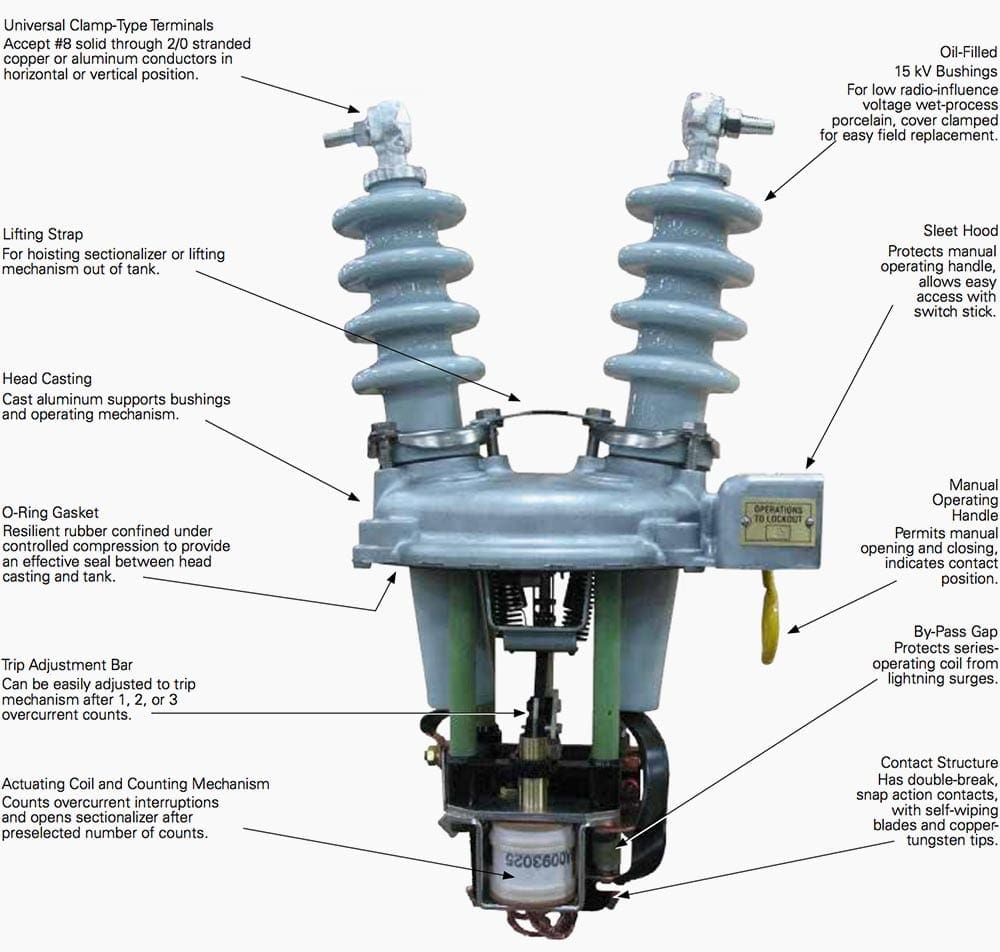Distribution system protection
Sectionalizers are (beside overcurrent relays, reclosers and fuses) one of the most used for distribution system protection.

A sectionalizer is a device that automatically isolates faulted sections of a distribution circuit once an upstream breaker or recloser has interrupted the fault current and is usually installed downstream of a recloser.
Sectionalisers count the number of operations of the recloser during fault conditions. After a preselected number of recloser openings, and while the recloser is open, the sectionalizer opens and isolates the faulty section of line. This permits the recloser to close and re-establish supplies to those areas free of faults. If the fault is temporary, the operating mechanism of the sectionalizer is reset.


Sectionalizers are constructed in single- or three-phase arrangements with hydraulic or electronic operating mechanisms.
IMPORTANT! A sectionalizer does not have a current/time operating characteristic and can be used between two protective devices whose operating curves are very close and where an additional step in coordination is not practicable.


Hydraulic operating mechanisms
Sectionalizers with hydraulic operating mechanisms have an operating coil in series with the line. Each time an overcurrent occurs, the coil drives a piston that activates a counting mechanism when the circuit is opened and the current is zero by the displacement of oil across the chambers of the sectionalizer.
After a pre-arranged number of circuit openings, the sectionalizer contacts are opened by means of pre-tensioned springs. This type of sectionalizer can be closed manually.
Electronic operating mechanisms
Sectionalizers with electronic operating mechanisms are more flexible in operation and easier to set. The load current is measured by means of CTs, and the secondary current is fed to a control circuit that counts the number of operations of the recloser or the associated interrupter and then sends a tripping signal to the opening mechanism.
This type of sectionalizer is constructed with manual or motor closing.


Factors to consider
The following four factors should be considered when (technically) selecting a sectionalizer:
- System voltage,
- Maximum load current,
- Maximum short-circuit level, and
- Coordination with protection devices installed upstream and downstream.
The nominal voltage and current of a sectionalizer should be equal to or greater than the maximum values of voltage or load at the point of installation.
The short-circuit capacity (momentary rating) of a sectionalizer should be equal to or greater than the fault level at the point of installation. The maximum clearance time of the associated interrupter should not be permitted to exceed the short-circuit rating of the sectionalizer.
Coordination factors that need to be taken into account include the starting current setting and the number of operations of the associated interrupter before opening.
Sectionalizer with surge arrester protection


References:
- Protection of Electricity Distribution Networks – Juan M. Gers and Edward J. Holmes (Purchase from Amazon)
- ABB AutoLink resettable electronic sectionalizers












Equations for thinking about midpoint recloser settings?
Good explanation thank you it helped me a little
Very educative
thanks for your good article, can u please let know how sectionaliser is counting number of operations of autoreclosers when both are distant apart , whether there is communication link between sectionaliser and autoreclosers for counting operations please
Sectionalizers with hydraulic operating mechanisms have an operating coil in series with the line. Each time an overcurrent occurs, the coil drives a piston that activates a counting mechanism when the circuit is opened and the current is zero by the displacement of oil across the chambers of the sectionalizer.
Yes right sr but hv line are the where’s the proper work in generation condition